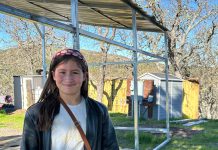To seed or not to seed?
Despite the cold weather, I find myself hanging around the seed
racks. The first day of spring is just eight days away. So, seeds
for the coming garden are a major interest even if the weather
seems to be working against gardeners.
To seed or not to seed?
Despite the cold weather, I find myself hanging around the seed racks. The first day of spring is just eight days away. So, seeds for the coming garden are a major interest even if the weather seems to be working against gardeners.
Why bother with seeds when you can buy transplants in six-packs and four-inch pots? Why worry and fret when greenhouse growers have done the basic work for you?
The answer to this depends on what you want from your growing experience. For some people, the act of successfully starting seeds is a big part of gardening. There is something enthralling about seeing a tiny plant struggle up through the soil – the first pumpkin seed to sprout or the beginning growth of sunflowers.
But, again, why seeds? The selection on the seed racks is vast compared to the transplants offered on nursery tables. The nursery formula is simple: Stock what moves quickly for fast turnover. Taking tomatoes as an example, you will find Early Girl, Better Boy, Ace, Sweet 100, and perhaps an heirloom or two such as Black Krim, among the started plants. But if you start tomatoes from seed, you can choose at least a dozen different varieties – probably more if you order from a catalog.
In addition, a seed packet contains from 10 to 50 or more seeds, depending on the size of the seeds. There is much more chance of success with a packet of seeds.
So, do you stop by the seed rack, or just walk on to the display table of seedlings? Back to the tomato question: Do you want one cherry tomato plant, or a full row of them? Are you willing to baby your seeds in their starter pots, or do you want instant gratification? Will you settle for a boring cherry tomato, or are you eager to experiment with Sweet Baby Girl, Big Beef, Husky Gold Cherry, Arkansas Traveler and Brandywine?
The same goes for flower seeds. The selection of flower types on the seed rack is huge, and yet the selection among transplants is fairly limited to certain varieties for quick turnover. In addition, there are some flowers that do not transplant well – sunflowers, for example, plus sweet peas, cardinal climber and California poppies. Their roots do not like to be disturbed so they do best when started from seed in the spot they will grow.
March is the time to start seed indoors in peat pots for moving outdoors once night temperatures stay above 50 degrees.
Use a packaged seed starting mix. There are a couple on the market, and I’ve had good luck with Seed Starting Potting Mix by Miracle-Gro. Buy fresh seeds packaged for the 2006 growing season. Seeds become less viable with each passing year. You might get decent results from last year’s seeds, but beyond 2005 they are not worth using. Why go through all this trouble using questionable seeds?
Start seeds indoors in individual peat pots or trays. There are other containers that work well, too, such as small milk cartons, frozen juice cans with the bottom cut out, and egg cartons. I like medium-size peat pots because the plant grows a decent size and then the entire peat pot can be planted in the ground without disturbing the roots.
Indoor starts need adequate lighting or the plants will become leggy as they search for light. Bottom heat helps. I put my starts on rubber heat mats (available at some garden supply stores). They are placed in a sunny window. This combination of sunlight and bottom heat seems to work just fine.
Place a sheet of Saran wrap lightly over the starts to form a loose-fitting mini greenhouse. Once the growth appears, remove the covering. It has done its job.
Once a plant shows two true leaves, there is the choice of transplanting to a bigger pot, or moving them outdoors into the garden beds. That choice depends on the weather. It would be pitiful to have gone through all this work and then have your tiny plants killed by late frost.
So, be patient. Nurse them along with sunlight and water. Move the pots outdoors during the day if the weather is mild. But wait for overnight warmth to set them outdoors.
I’ll see you at the seed racks.
A Reader Wants to Know: I would like to find a daphne bush. Any ideas where to look? I am in Morgan Hill and have tried the local garden centers here and in Gilroy. I’ve been told the deaphnes were never sent this year. – Mary
Joan Says: Oh, my, yes. Daphne. There are a couple of daphnes on the market, but the one grown in California is Daphne odora, or winter daphne. Sunset Western Garden Book describes daphne as “unpredictable.” That’s putting it mildly. It can die despite the best gardening care. It can flourish even though it is ignored. The common belief is that your daphne either likes you or hates you. If it likes you, it will grow. Otherwise, forget it.
Daphne arrives at nurseries in fits and spurts. Keep checking around and it will show up eventually at one nursery or another. A growing tip: daphne likes at least three hours of shade each day. And easy on the watering, as water mold is a common root problem.
P.S.: A follow-up to this question. Mary writes that she found her daphne at SummerWinds Garden Center, 4606 Almaden Expressway at Branham Lane, San Jose.









